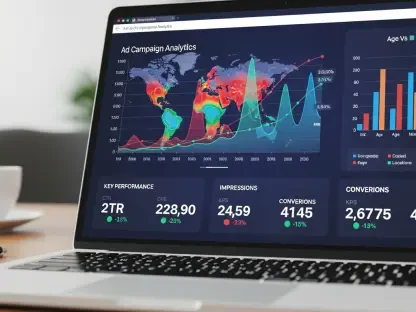Introduction to a Changing Landscape
Imagine driving through the bustling streets of Muscat, where towering billboards and vibrant street furniture displays catch the eye at every turn, but now, these advertisements seem to know exactly who passes by and when. Out-of-home (OOH) advertising in Oman has entered a transformative phase, propelled by data-driven strategies that are redefining how brands connect with audiences. This shift from traditional visibility-focused campaigns to precision-targeted messaging marks a pivotal moment for the industry, raising questions about effectiveness, accountability, and innovation in a rapidly evolving market. As data becomes the cornerstone of advertising decisions, the OOH sector in Oman stands at the forefront of a digital revolution, promising deeper insights and measurable impact for advertisers.
The Evolution of OOH Advertising in Oman
The OOH advertising landscape in Oman has long been shaped by its emphasis on prime locations and high visibility, with billboards and street furniture dominating urban centers like Muscat and Salalah. Historically, success in this medium relied heavily on placing advertisements in high-traffic areas, often without precise tools to measure their impact. This approach, while effective in capturing attention, lacked the depth to understand audience engagement beyond surface-level exposure.
Today, the industry is witnessing a significant transformation, driven by key players like JCDecaux Oman, who are steering the sector toward data-centric methodologies. The current market reflects a blend of traditional formats and modern innovations, with companies increasingly prioritizing analytics to enhance campaign outcomes. This evolution underscores a broader recognition of OOH as an indispensable medium, particularly in urban and suburban areas where it reaches diverse demographics daily.
The importance of OOH advertising in Oman cannot be overstated, as it remains a powerful tool for brand visibility amidst growing digital competition. Its ability to engage consumers in public spaces, combined with the integration of data insights, positions it as a critical component of integrated marketing strategies. As the industry adapts to new technologies, the focus is shifting from mere presence to meaningful interactions with target audiences.
Data-Driven Innovation in OOH Advertising
The Role of Audience Intelligence Platforms
A groundbreaking partnership between JCDecaux Oman and Streach, an audience intelligence platform by Seventh Decimal, is reshaping the OOH advertising scene in Oman. This collaboration introduces advanced analytics into street furniture advertising, enabling brands to move beyond guesswork and tap into detailed consumer insights. By leveraging Streach’s technology, JCDecaux Oman is pioneering a data-driven approach that prioritizes audience behavior over static location metrics.
The platform provides a wealth of metrics, including Pass-Bys, Reach, Impressions, Frequency, and comprehensive consumer profiles that detail travel habits and visitation trends. These insights allow advertisers to understand not just where people are, but who they are and how they move through their daily routines. This shift in perspective facilitates more strategic campaign planning, ensuring messages resonate with the right individuals at optimal times.
Ultimately, this focus on mobility patterns and consumer demographics transforms OOH advertising into a more dynamic and responsive medium. Campaigns can now be tailored to specific audience segments, maximizing relevance and engagement. The partnership sets a precedent for how technology can elevate traditional advertising formats, making them more aligned with modern marketing demands.
Impact and Performance Metrics
A recent study of JCDecaux Oman’s Street Furniture portfolio, spanning over 600 advertising faces from Seeb to Muttrah, revealed staggering results that highlight the power of data integration. The study achieved a remarkable 97.65% population reach and generated over 950 million impressions in a single month, demonstrating the scale and effectiveness of data-enhanced OOH campaigns. These numbers provide a clear benchmark for what is possible when analytics underpin advertising efforts.
Such metrics bring a new level of accountability to the industry, allowing advertisers to measure campaign performance with unprecedented precision. The ability to track impressions and reach translates into improved return on investment (ROI), as brands can fine-tune their strategies based on real-time feedback. This data-driven approach ensures that every advertising dollar is spent with purpose, targeting audiences more effectively.
Moreover, these performance indicators are redefining industry standards in Oman, setting a high bar for competitors and collaborators alike. Advertisers now have access to tangible evidence of campaign success, fostering trust and encouraging further investment in OOH. As these metrics become the norm, they pave the way for a more transparent and results-oriented advertising ecosystem.
Challenges in Adopting Data-Driven OOH Strategies
Integrating data analytics into OOH advertising in Oman presents several challenges that must be addressed for widespread adoption. Technological barriers, such as the need for sophisticated infrastructure and software, can pose significant hurdles, especially for smaller players in the market. Additionally, the cost of implementation may deter some companies from embracing these innovations, as initial investments in data tools can be substantial.
Another critical concern lies in data privacy, as collecting and analyzing consumer information raises questions about compliance with local regulations and ethical standards. Ensuring that data is gathered and used responsibly is paramount to maintaining public trust, yet it requires robust systems and constant vigilance. Without proper safeguards, the industry risks facing backlash that could undermine the benefits of data-driven advertising.
To overcome these obstacles, strategic partnerships, such as the one between JCDecaux Oman and Streach, can provide access to expertise and scalable solutions. Investing in training for professionals to interpret and apply data effectively is also essential, as is the adoption of cost-effective technologies that cater to varying budget levels. By addressing these challenges head-on, the OOH sector can ensure a smoother transition to a data-centric future.
Regulatory and Ethical Considerations in Data Usage
The regulatory framework governing data usage in Oman’s advertising industry is a critical factor in shaping how data-driven OOH strategies are implemented. Privacy laws and compliance requirements demand that companies handle consumer information with care, adhering to strict guidelines to protect personal data. Navigating this landscape requires a thorough understanding of legal obligations to avoid penalties and reputational damage.
Ethical considerations are equally important, as transparency in data collection practices builds consumer confidence in the advertising process. Brands and media owners must prioritize clear communication about how data is used, ensuring that audiences feel respected rather than exploited. This commitment to ethical standards not only aligns with regulatory expectations but also enhances long-term relationships with the public.
Furthermore, aligning data practices with national objectives, such as those outlined in Oman Vision 2040, reinforces the role of OOH advertising in sustainable development. By adhering to regulations and ethical principles, the industry contributes to broader goals of innovation and societal progress. This alignment ensures that data-driven advancements in advertising support both commercial interests and the Sultanate’s vision for a diversified economy.
The Future of OOH Advertising in Oman
Looking ahead, data is poised to further revolutionize OOH advertising in Oman through advancements like real-time analytics and personalized targeting. The ability to adjust campaigns on the fly based on live data inputs could redefine how brands interact with consumers in public spaces. Such innovations promise to make OOH an even more agile and impactful medium, capable of responding to immediate market shifts.
Emerging trends, including integration with smart city initiatives, are also expected to play a significant role in shaping the industry. As Oman advances under Vision 2040’s focus on innovation and economic diversification, OOH advertising can align with urban development projects to create seamless, technology-enhanced experiences. This synergy between advertising and infrastructure development positions the sector as a key player in national progress.
Additionally, global technological and economic trends are likely to influence the local OOH market, offering opportunities for Oman to emerge as a leader in data-driven advertising. By staying ahead of international developments, such as programmatic buying and AI integration, the country can establish itself as a hub for cutting-edge marketing solutions. This forward-looking approach ensures that OOH remains relevant in an increasingly competitive landscape.
Reflecting on a Transformative Journey
Looking back, the journey of OOH advertising in Oman illustrates a remarkable shift, driven by the pioneering efforts of JCDecaux Oman and Streach in integrating data analytics into traditional formats. This collaboration redefined campaign precision and accountability, setting new standards with impressive metrics that underscored the potential for transformative impact. The alignment with national goals like Oman Vision 2040 further highlighted how industry advancements contributed to broader societal benefits.
For the road ahead, advertisers and stakeholders should focus on sustained investment in data-driven tools to maintain momentum and relevance in a dynamic market. Embracing scalable technologies and fostering skill development among professionals will be crucial to overcoming existing challenges. Additionally, prioritizing ethical data practices can ensure that consumer trust remains intact, supporting long-term growth.
Beyond immediate actions, exploring deeper integrations with smart city frameworks and global innovations offers a pathway to elevate OOH advertising further. By committing to continuous improvement and strategic partnerships, the industry can unlock new opportunities for engagement and impact. This proactive stance will solidify Oman’s position as a frontrunner in reimagining outdoor advertising for the digital age.









